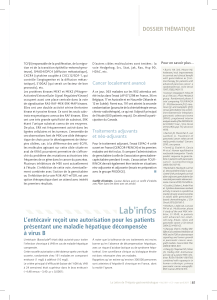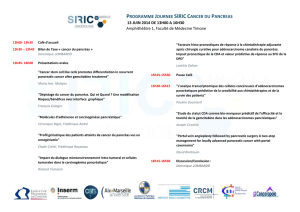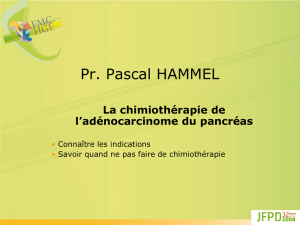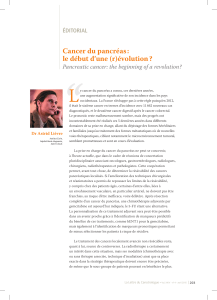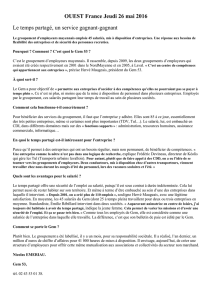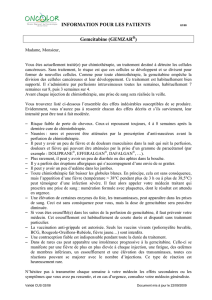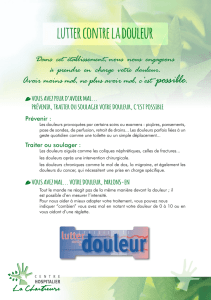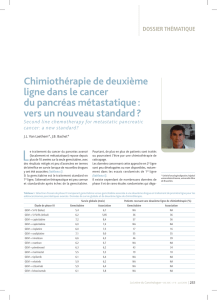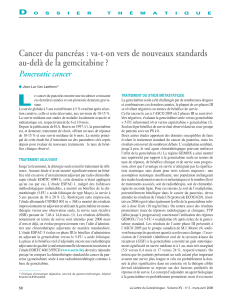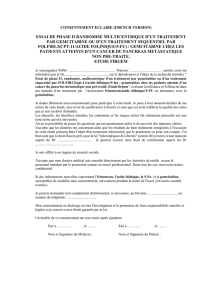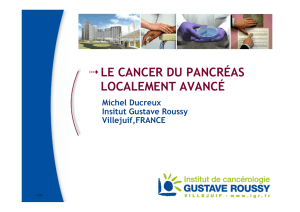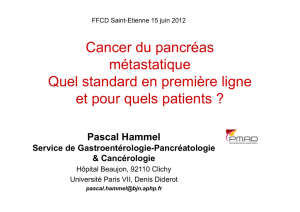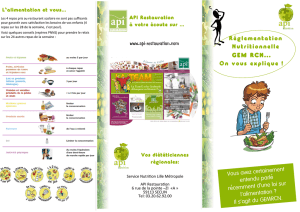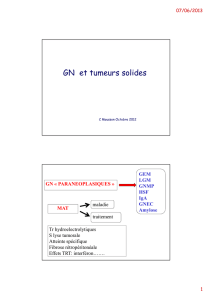Phase III Trial
publicité
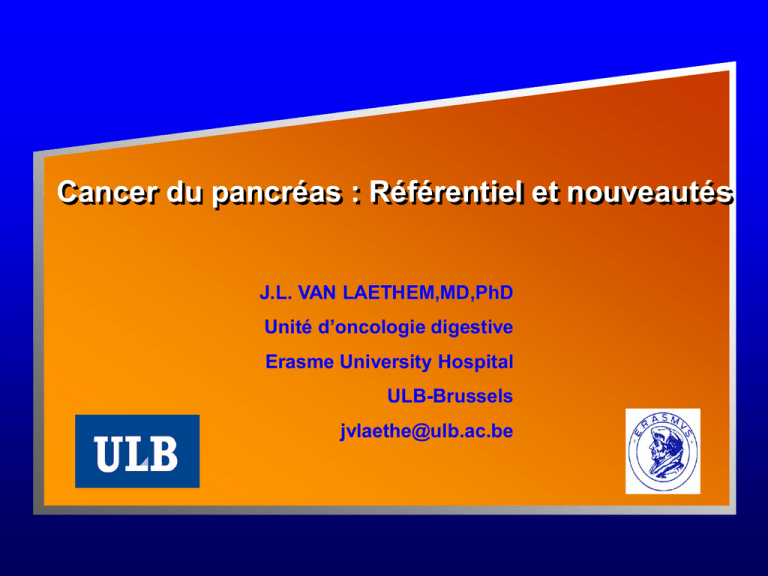
Cancer du pancréas : Référentiel et nouveautés J.L. VAN LAETHEM,MD,PhD Unité d’oncologie digestive Erasme University Hospital ULB-Brussels [email protected] PANCREATIC CANCER Late diagnosis Palliative treatment 90% LAD Metastatic R0 surgery 10% 5 y. survival: 10-20% disease 3-6 months 8-12 months 18-20 months MEDIAN SURVIVAL Options thérapeutiques dans le cancer du pancréas Ere du 5FU et des « BSC » Ere de la Gemcitabine Ere des cytotoxiques combinés Ere des agents biologiques Chemo(bio)radiation 1.Approche systémique <> métastatique 2.Approche Loco-régionale 3.Approche curative INNOVONS !!! 1997 : the Burris study Gemcitabine as a new standard : median survival =6 months 1997-2006 : no major benefit of combining cytotoxics,no new active chemotherapy 2005-2007 : anti EGFR therapy erlotinib added to GEM : small benefit in survival (+ 0.5 month !) ; better in patients with grade 2 rash 2007: biologics disappointing ! No survival benefit median survival = 6.4 months Traitement systémique Quel standard? Quels cytotoxiques? Apport des biologiques? Gemcitabine: the standard of care since 1997 Gemcitabine 5-FU P value Patients (n) Clinical benefit response 63 63 23.8% 4.8% 0.0022 Tumour response 5.4% 0% ND Survival 5.65 mo 4.4 mo 0.0025 Time to progression 2.1 mo 0.9 mo 0.0002 18% 2% 0.0025 1-year survival 5-FU=5-fluorouracil ND = Not determined Burris et al. J Clin Oncol 1997 Combinaisons Gem + cytotoxics phase III trials Auteur Traitement n GEM-CPT-11 360 6.3 mois NS Heineman (2003) GEM-CIS 195 7.6 NS O'Reilly (2004) GEM-DX 349 6.2 NS Richards (2004) GEM-PMX 565 6.7 NS Louvet (2005) GEMOX 313 9.0 NS Berlin (2003) GEM-5FU bolus 322 6.7 NS Riess (2005) GEM-5FU/LV 466 5.8 NS Hermann (2005) GEM-cape 319 8.4 NS Cunningham (2005) GEM-cape 533 7.4 HR 0.8 GEM 30’ 279 4.9 NS GEMOX 276 5.9 NS GEM FDR 277 6.0 HR 0.83 Rocha-lima (2003) Poplin (2006) Survie médiane p . Overall survival analysis: gemcitabine versus gemcitabine-based combination (Combo) chemotherapy Copyright © American Society Clinical Oncology 25:2607-2615 2007 Sultana, A. et al. J ofClin Oncol; Subgroup analysis of the different gemcitabine-based combination (Combo) chemotherapy regimens Copyright © American Clinical Oncol; Oncology Sultana, A. etSociety al. JofClin 25:2607-2615 2007 Cytotoxiques: tendances Metaanalyses 1: – GEM combo better than GEM alone platinum-based capecitabine – GEM vs 5FU: ? unconclusive – chemotherapy better than BSC Sultana, JCO 2007 Metaanalyses 2: – GEM combo better than GEM alone platinum-based capecitabine good PS Heinemann, Proc ASCO 2007,Ann Oncol 2007 FolFirinox vs GEM: phase II (n = 44/arm) RR: 38.7% vs 11.7% phase III Ychou, Proc ASCO 2007 CDDP/LV5FV2 vs GEM and cross-over in 2nd line FFCD trial awaited De la biologie moléculaire à la thérapie Quelles sont les données moléculaires qui caractérise le cancer du pancréas? Comment exploiter les nouvelles cibles moléculaires et quel sera le gain thérapeutique? Comment évaluer et prédire rapidement l’activité anti tumorale? Molecular Targets in Pancreatic Cancer Growth Factor Ligand (EGF, VEGF) ECM Integrin Homodimer ras Y FAK Y Y raf MEK Src Y Y Y PI3K EGF Receptor Pro-MMP Akt ERK Nucleus Regulation of Gene Transcription Molecular Events in Pancreatic Cancer Oncogene Activation / Overexpression – K-ras Receptor Tyrosine Kinase Overexpression – HER2/neu – Epidermal Growth Factor Receptor Tumor Suppressor Mutations – p 53 – p 16 – SMAD4 (DPC4) Nuclear Transcription Factor Activation Other Events – Angiogenesis – VEGF, IL-8 – Invasion – Cadherins, Matrix Metalloproteinases – Inflammation – NFkB Molecular Events in Pancreatic Cancer Target Intervention Cell Membrane Proteins – HER2/neu Herceptin – EGFR Antibodies, RTKls – MMPIs MMPI inhibitors – VEGF(R) Antibodies, RTKis Signaling intermediates – Raf-1 Raf-1 Kinase inhibitors (BAY-439006) – Akt LY294002 – mTOR CCI-779, RAD001 Nuclear Transcription Factors – NF-kB Natural Products, Velcade, IKK inhibitors – Sp-1, Sp-3 Disrupt DNA binding – PPAR agonists,LY293111 Expression de l’EGFR dans les tumeurs solides Colorectal Colorectal cancer Lung (NSCLC) Head & neck (SCCHN) Head & neck cancer 60–80% 95–100% Lung cancer (NSCLC) 40–80% Breast cancer 14–91% Ovarian cancer 35–70% Pancreatic cancer 30–89% Cunningham et al. N Engl J Med 2004;351:337-345. Grandis et al. Cancer 1996;78:1284-1292. Salomon et al. Crit Rev Oncol Hematol 1995;19:183-232. Walker, Dearing. Breast Cancer Res Treat 1999;53:167176. Proportion surviving with NED Disease-free survival, EGFR and TGF expression in patients with pancreatic carcinomas EGFR TGFα 1.0 1.0 low 0.8 low 0.8 medium 0.6 0.6 0.4 medium 0.4 high 0.2 0.2 p=0.0001 0.0 0 1 high p=0.0001 0.0 2 3 4 5 6 0 1 2 3 4 5 6 Years after surgery Friess et al. Cancer Res 1993 Phase III R STRATIFICATION A GEMCITABINE 1000 mg/m2, IV N ERLOTINIB CENTER D PS (0/1 vs. 2) O STAGE OF DISEASE M 100/150 mg, ORAL n = 569, 25% LA I Z E GEMCITABINE 1000 mg/m2, IV PLACEBO 100/150 mg, ORAL • OVERALL SURVIVAL • PFS • QOL Moore, JCO 2007 NCIC-CTG PA.3 Study: Overall Survival (100-mg Cohort) 100 HR: 0.81 95% CI: 0.67-0.98 P = .03 Survival, % 80 60 40 Gemcitabine + Erlotinib Median survival: 6.37 months 1-year survival: 23% 20 Gemcitabine + Placebo Median survival: 5.95 months 1-year survival: 17% 0 0 6 12 Months Moore MJ, et al. J Clin Oncol. 2007;25:1960-1966. 18 24 NCIC-CTG PA.3 Study: Rash vs Survival Survival correlated with severity of rash, but not EGFR expression 100 HR: 0.74 P < .037 Survival, % 80 Grade 2 60 40 Grade 0 Grade 1 5 10 Months 20 0 0 15 Moore MJ, et al. J Clin Oncol. 2007;25:1960-1966. 20 Outcome Rash Severity Gr 0 Gr 1 Gr ≥ 2 (n = 79) (n = 102) (n = 101) Median survival, mos 5.3 5.8 10.5 1-year survival, % 16 9 43 How to predict survival? Ki-ras mutation and EGF-R expression Samples from 117 pts (< 569 in the PA 3 study) Ki-ras mutant (79% pts): better survival than WT unexpected Among K-ras mutant: gem gem + T expected Among K-ras WT: gem + T gem expected Fish neg (53% of the pts) better than Fish + expected Among Fish pos, gem + T = gem unexpected Among Fish neg, gem + T > gem unexpected Moore, Proc ASCO 2007; Louvet, Discussion, ASCO 2007 First-Line Gemcitabine ± Cetuximab: SWOG S0205 Phase III Trial Stratified by disease status, Zubrod PS (0/1 vs 2), prior pancreatectomy Patients with locally advanced or metastatic pancreatic adenocarcinoma (N = 735) Gemcitabine 1000 mg/m2/week for 7 of 8 weeks, then 3 of every 4 weeks (n = 366) Gemcitabine 1000 mg/m2/week for 7 of 8 weeks, then 3 of every 4 weeks + Cetuximab 400 mg/m2 Week 1, then 250 mg/m2 weekly (n = 369) Primary endpoint: overall survival Philip PA, et al. ASCO 2007. Abstract LBA4509. First-Line Gemcitabine ± Cetuximab: SWOG S0205 Results No significant difference in overall or progression-free survival between gemcitabine vs gemcitabine/cetuximab arms Time to treatment failure prolonged with gemcitabine/cetuximab (P = .0014) No significant difference in response rates between arms No major toxicity differences between arms – Slightly higher incidence of grade 3/4 rash and allergic reaction in gemcitabine/cetuximab arm Philip PA, et al. ASCO 2007. Abstract LBA4509. Cancer du pancréas et antiangiogénèse Target Anti Target Nom VEGF mAb Bevacizumab (Avastin®) VEGF-R1-2-3 TKI PTK 787 (Schering) VEGF-R2-3 TKI Axitinib (Pfizer) TKI AZD2171 (AZ) Raf- KI BAY-439006 (Bayer) PDGFR VEGF-Rs Raf-kinase VEGFR PDGFR (Sorafenib) Gemcitabine ± Bevacizumab: CALGB 80303 Phase III Trial Stratified by disease status, ECOG PS (0/1 vs 2), prior radiotherapy Patients with advanced pancreatic adenocarcinoma (N = 602) Bevacizumab 10 mg/kg, Days 1 and 15 + Gemcitabine 1000 mg/m2, Days 1, 8, and 15 of 28-day cycle (n = 302) Placebo, Days 1 and 15 + Gemcitabine 1000 mg/m2, Days 1, 8, and 15 of 28-day cycle (n = 300) Primary endpoint: 35% improvement in survival (from 6 to 8.1 months) Kindler HL, et al. ASCO 2007. Abstract 4508. Gemcitabine ± Bevacizumab: CALGB 80303 Results No significant difference in overall or progression-free survival between gemcitabine vs gemcitabine/bevacizumab arms – Median survival: 6.1 vs 5.8 months, respectively Patients with locally advanced disease had longer overall survival vs patients with metastatic disease – 9.9 vs 5.7 months, respectively (HR: 1.4; P = .009) Patients with better PS had longer overall survival (PS 0 > PS 1 > PS 2) – 8.0 vs 4.8 vs 2.8 months, respectively (P = .0001) No significant difference in response rates between arms No major toxicity differences between arms, except – Higher incidence of hypertension and proteinuria in gemcitabine/cetuximab arm Kindler HL, et al. ASCO 2007. Abstract LBA4508. Gemcitabine + Erlotinib ± Bevacizumab: AVITA (BO17706) Phase III Trial Gemcitabine + Erlotinib + placebo Patients with previously untreated metastatic pancreatic adenocarcinoma (N = 600) Gemcitabine + Erlotinib + Bevacizumab 5 mg/kg every 2 weeks Primary endpoint: improvement in overall survival (from 6.9 to 9.0 months) Results pending for 2008 www.roche-trials.com/patient/trials/trial11.html Thérapies ciblées: non convainquantes MMI: marimastat: 2 negative trials monotherapy vs combo Moore 2003; Bramhall 2002 FTI: Tipifarnib: 1 negative trial Van Cutsem 2004 Her-neu 2 targeting: Herceptin: disappointing phase II Safran 2001 Sorafenib: not active with gem phase I (n = 17) Wallace, Proc ASCO 2007 Lapatinib: Her-1/Her-2 targeting preliminary data in bilio-pancreatic cancer; inconclusive Safran, Proc ASCO 2006 Thérapies ciblées: activité à confirmer TGF-2 inhibitor AP 12009: phase I/II n = 17 (P, C, M) one CR Oettle, Proc ASCO Curcumin: NF-Kappa B inhibitor : phase II : n = 25 prolonged SD bio-immunological response Dhillan, Proc ASCO 2007 Sunitinib/axitinib : VEGR 1/2/3 inhibitor phase II: OS 6.9 vs 5.6 (G + Ax vs G) phase III Spano, Proc ASCO 2007; ECCO 2007 Thérapies ciblées: activité en attente VEGF-trap: phase III en route: G +/- Aflibercept Telomerase: GV-1001 vaccine: phase III en route AEE-788: EGFR/VEGFR inhibition RAD-001: mTOR inhibitor Ras/Raf/MEK/ERK cascade: CI 1040 inhibitor (MEK 1-2) Bcl-2 / Bcl-xL: Apo G2 IGF-R inhibitor… AURORA kinase… Phase II et III en seconde ligne dans le cancer du pancréas Regimen PR SD Median OS (%) (%) for 2d line (weeks) 30 23.3 30 25 18 0 16 ND 18 5 27 17.5 30 11 57 27 Oettle (2005) 23 ND ND 21* Vs BSC Phase III 23 CPT-11/FA/5-FU Ng (2005) 15 0 38 14 33 22 38 25 Oxali/LV/5-FU Authors & phase Tsavaris (2005) Number of patients Phase II Oxali Androulakis (2005) Phase II Paclitaxel Oettle (2000) Phase II Capecitabine/ erlotinib Oxali/FA/5-FU Blaszkowsky (2005) Phase II 10 Phase II GEMOX Van Laethem (2005) Phase II Aucun standard ! Thérapie systémique: messages Peu d’avancées 10 ans pour gagner 0.5 mois de survie Biologiques décevants (Avastin, cetuximab) Standard = gemcitabine …. + tarceva …. Si on comprend pour qui et pourquoi Combinaisons: oui ; PS 0 < gain modeste en survie (Méta Analyses) Changer le design des études : stop larges phases III Investiguer les combinaisons hors gem Intérêt d’études en 2e ligne Thérapie loco-régionale Sélection des patients Quelles stratégies? CT suivi de CTRT ? CT vs CTRT? Role délétère de la RT? Peut on rendre résécable une tumeur non résécable? Approche néoadjuvante dans le cancer du pancréas N’est pas un standard! Nécéssite un staging précis par EUS + pct, Helical CT + angio CT ou MR et un preuve cyto et un drainage biliaire adéquat Différentier les situations suivantes: Resecable chirurgie ou neoadj protocol borderline res Non resecable Tentative de résection chimiothérapie ou neoadjuvant protocol chimioRT ? Confrontation multidisciplinaire basée sur le staging vasculair Pancreatic cancer staging Grade1: up to 1/4 circ Grade 3: 1/2 -3/4 circ Grade 2: 1/4 - 1/2 circ Grade 4: > 3/4 circ Yoshiura, J CAT 2005 Retroperitoneal Margin SMV SMA RP margin Gemcitabine can be safely combined with radiation therapy Gemcitabine active in advanced PC Gemcitabine is a potent radiation sensitizer of tumour pancreatic cells in vitro Gemcitabine has only minor toxicity and can be easily administered in an outpatient basis increasing evidence of feasibility and activity of GEM + RT in PC (phases I-II) – neoadjuvant setting (Wolffs et al) – locally advanced disease (Blackstock et al) – adjuvant setting (Van Laethem et al, EORTC GI/RT group) Preop gem + cisplatin followed by rapid fr. chemoradiation for resectable pancreatic adc Phase I-II study: gem 400 mg/m2 w + 30 Gy EBRT (proc ASCO 2002, Mc Ginn) Varadhachary et al (Proc ASCO 2006, abs 4.37) – n = 77 stage I-II pancreatic head cancer – gem/cis x 4 cycles q 2 w then gem 400 mg/m2 w + 30 Gy EBRT restaging 4-6 weeks after the last dose • 10 PD • 61 on surgery: 44 pts R0 resection; pPR (> 50% tumor kill) = 61% – tox: preop stent occlusion: 44%; GI tox gr 3; gr ¾ neutro: 29% – MS 21 months Pre-clinical evidence of the combination of Erbitux with radiation Baselga. Eur J Cancer 2001;37:S16–S22. Neoadjuvant strategies: novel combinations Gemcitabine-based chemoradiation – feasible – toxicity non negligeable but manageable – active (pPR-CR) – no phase III Gemcitabine + platinums + capecitabine + paclitaxel bevacizumab cetuximab erlotinib phase I-II Chemotherapy before chemoradiation strategy can improve outcome… Non randomized evidence Belgian Phase I Trial Gem/Cetuximab with RT dose Escalation for LA/Marginally Resectable Disease Surgery Further Rx Gem + C225 + RT (36, 55, or 50.4 Gy) Staging Gem 300 mg/m2 weekly C225 400 then 250 mg/m2 weekly EBRT: 36/45/50.4 Gy Reevaluation A Demols,JL van Laethem, personal communication Bevacizumab + capecitabine + RT in LAD Phase I trial n = 48 Beva: 2.5, 5, 7.5, 10 mg/kg q2w Cape: 650-825 mg/m2 bid RT: 50.4 Gy Toxicity: GI gr 2 (43%), gr 3 (4%) hemato gr 4 (13%), HFS (13%) 3 tumor-associated duodenal ulceration with bleeding (3, 10 and 20 w after RT) 1 tumor-associated duodenal perforation Efficacy: 9/45 PR (20%) median: 6.2 months 7/45 MR (15%) 27/45 SD (60%) MS: 15.2 months Dose: 5 mg/kg BV Crane, Proc ASCO 2005 IRM Pre et Post traitement 08 / 2005 02/ 2006 Gemox X 2 GEMOX + RT 45 Gy (Peeters-Van Laethem, ESMO 2006 ) Pre and post-treatment Angio-MR 08 / 2005 02 / 2006 CTRT vs CT in LAD for palliation ? Randomized Phase III : Chauffert et al, ASCO 2006 Initial CT/RT Gem vs Gem alone CT= Cisp w 1/5, 5FU 300mg/m2 inf w1-6 ; RT= 60 Gy (2Gy/fr) ; Gem= 1000 mg/m2/w End point= OS 6 12 months 176 patients First-intention CRT : FFCD-SFRO trial Chauffert. ASCO 2006, # 4008 0.00 0.25 0.50 0.75 1.00 Overall Survival according to treatment arm 0 3 6 9 12 15 18 21 24 Time in Months Gemcitabine 27 30 33 36 39 CHRT 109 patients included, median f.u. : 16 months [1 – 60] Median survival : CRT = 8 months vs gemcitabine = 14 months 1-year survival : CRT= 24 % vs gemcitabine = 51 % CTRT vs GEM CTRT (n=59) Dose >75% : RT 81% 5FU 52% cisP 51% OS 6 m 78% 12 m 24% med 8.4 m Toxicity gr 3/4 leuco 17% thrombo 8.5% non hémato 37% GEM (n=60) Gem 76% 82% 51% 14.3 m p=0.014 10% 0% 17% Chauffert et al,ASCO 06 Chemoradiation after chemotherapy induction Background (2) : selection CT 10.8 months vs 7,4 months (p = 0.005) CRT may increase survival in patients with LA disease stable after 3 months chemotherapy compared to CT continuation 15 months vs 11,7 months (p = 0.0009) Study for the Locally Advanced cancer of the Pancreas LAP 07 PI: P. Hammel June 2007 The LAP 07 study focuses on LA cancer with 2 questions : Role of CRT in patient with controled disease? Role of erlotinib in this form of cancer ? Study for the Locally Advanced cancer of the Pancreas LAP 07 A : Gem 4 months R1 B : Gem + erlotinib (100 mg) 4 months Non progressive disease A1: Gem 2 months, then stop A2 : RCT, then stop R2 B1 : Gem + erlotinib (100 mg) 2 months + erlotinib maintenance (150 mg) B2 : RCT + erlotinib maintenance Thérapies loco-régionales: messages Evaluer « finement » la résécabilité Chirurgie vs traitement d’induction en vue 2d look Combinaisons innovantes + RT Pas de RTCT d’emblée Sélection des patients controllés par CT d’induction (étude observationnelle-phase III planifiée) La gemcitabine reste le standard Approche standard des tumeurs résécables Pancreaticoduodenectomie (Whipple) 10-20% survie à long terme Morbidité et mortalité significative ( inversement correlée à l’experience) Marges positives fréquentes (retropéritonéales) 20 - 30% patients ne recoivent pas de thérapie postopératoire Adjuvant Therapy: Pas de consensus entre US et Europe GITSG1 –Survival advantage for chemoradiation followed by 5-FU for 1 year, but • Early termination, and • Slow accrual (43 patients in 8 years) EORTC2 –No survival benefit for chemoradiation, but no maintenance chemotherapy 1. Kaiser MH, et al. Arch Surg. 1985;120:899-903. 2. Klinkenbijl JH. Ann Surg. 1999;230:776-782. Adjuvant Chemotherapy: Outcomes CONKO-001: Disease-Free Survival ESPAC-1: Survival 75% 100% 50% Survival (%) Cumulative Disease Free Survival 100% gemcitabine 25% 75% 50% Chemotherapy 25% observation No chemotherapy 0% 0% 0 12 24 36 48 Months Oettle H, et al. J Am Med Assoc. 2007;297:267-277. 60 72 84 0 12 24 36 Months 48 60 72 Neoptolemos JP, et al. NEJM. 2004;350:1200-1210. Adjuvant therapy:ESPAC1 survival results Arm Median survival chemoRT 15.9 m No CTRT 17.9 m ChemoT 20.1 m No chemoT 14.7 m HR p 2-year survival 5-year survival 1.28 .05 29% 10% 41% 20% 40% 21% 30% 8% 0.71 .009 Adjuvant therapy in pancreatic cancer: Gemcitabine is useful Randomized multicenter phase III study: CONKO-001 n = 368 after R0/R1 surgical resection observation DFS 6 months; OS R Gemcitabine x 6 cycles Stratification: T, N, grade, R S + Gem S alone n 186 182 R1 surgery 19% 16% mDFS 14.2 months 7.46 months 19.3 m 11.2 m 0 1 13.1 m 7.0 m 14.0 m 7.9 m 0 1 14.5 m 5.5 m N R P<0.01 Neuhaus, Proc ASCO 2005 RTOG 9704 / US INTERGROUP Phase III Study (Schema) Resected AdenoCa of the Pancreas Nodal Status Neg. vs. Pos. ARM 1: Pre-CRT 5 – FU + CHEMORADIATION (CRT) + Tumor Diameter Post – CRT 5 – FU < 3cm vs. >3 cm ARM 2: Pre-CRT GEMCITABINE Surgical Margins + CHEMORADIATION (CRT) Neg. vs. Pos. Vs. Unknown + Post – CRT GEMCITABINE RTOG 9704 / US Intergroup Phase III Adjuvant Study Overall Survival – ‘Pancreatic Head’ Pts Only 100 / // / / / 75 % ALIVE Total Dead MST / CRT + Gemcitabine 187 CRT+ 5-FU 194 134 1.72 156 1.41 / / 50 / / / 25 p = 0.033 / // / // /// // // // / // / //// Median: 20.6 vs 16.9mos 3-Year: 32% vs 21% / /// // // 0 0 Patients at Risk RT + GEM RT + 5FU 1 2 3 4 YEARS FROM RANDOMIZATION 187 194 134 132 77 63 46 31 24 19 Thérapie adjuvante : recommendations USA: – Chirurgie suivie par adjuvant chemoRT (5FU)+/gemcitabine (RTOG 9704) – preop chemoRT (gemzar ou cape + biologics) en development Europe: – Chirurgie +/- chimiothérapie (5FU + Ac Fol ou Gem) – adjuvant CTRT (5FU ou gem) :optionnel – Randomiser les patients :EORTC 40113-22012/FFCD 3304: GEM vs GEM + RT) ? phase III Adjuvant treatment in pancreatic cancer EORTC/FFCD 40013 intergroup trial Resected pancreatic Gemcitabine x4 R cancer R0 Gemcitabine x2 Gem + RxT (50.4 Gy) Phase II-III trial Endpoints: feasability- survival, DFS (+ 10%) Patients required: 80/ 490 www.eortc.be Pancreatic cancer : what we need To Target new molecular pathways To assess efficiently and comprehensively innovative drugs and combinations To use new models /platforms for translational research // (pre)clinical evaluation before embarking large and costly phase III trials To test enriched pts population based on early development findings To transfer relevant active therapy in the periop setting in order to develop new multimodal strategies Pancreatic cancer Predictive factors of prognosis and response Tumor suppressor genes p53, DPC4 Microsatellite instability hMSH2 / hMLH1 Growth factors EGF, PDGF, TGF, TGF-RII Hypoxic/vascular factors microvascular density, VEGF,IL8 Cell proliferation Ki 67,Cyclin D1 Apoptosis BAX, Bcl-2 Invasion Annexins,integrins,chemokines Genomics > 2002 Proteomics > 2005 (Chen et al, Gastroenterology 2005) translational research program attached to clinical trials
